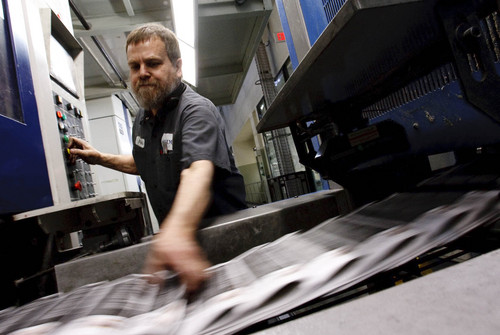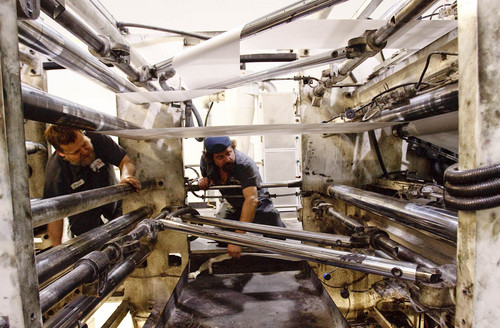This is an archived article that was published on sltrib.com in 2014, and information in the article may be outdated. It is provided only for personal research purposes and may not be reprinted.
Numbers, of course, can be read many ways— and that includes the business of reading news.
One view of new circulation audits for Salt Lake City's battling newspapers seems to bolster claims that a recent reworking of the two dailies' decades-old partnership is patently unfair. Seen another way, the figures appear to reflect a new world in Utah's media markets.
The latest audits show The Salt Lake Tribune has a daily print circulation of 61,475, compared with 40,179 for the Deseret News.
Despite The Tribune's hefty advantage in weekday circulation, the revised joint-operating agreement (JOA) gives the LDS Church-owned News a 70 percent to 30 percent edge in print profits.
In separate measures of what is called penetration — the newspapers' relative shares of markets attractive to local advertisers in the Salt Lake City area and northern Utah — The Tribune also enjoys a significant lead, according to the new figures from the advertiser-backed Alliance for Audited Media.
"In the areas where the two papers have traditionally served readers, The Tribune is far and away the stronger paper," said Joan O'Brien, a leading critic of the newly drafted pact, which she warns has put The Tribune's finances on a steep decline.
—
Taking inventory • Efforts by O'Brien, a former Tribune staffer who is married to a reporter at the paper and is the daughter of late Tribune Publisher Jerry O'Brien, have helped spark an investigation by the U.S. Department of Justice into the newspaper deal.
But the circulation audits released this month also lend weight to the News' growing business clout in the long-standing partnership. In the industry benchmark measure of Sunday audiences, the News is ahead, with a combined print-PDF-mobile reach of 207,480 on Sundays, compared with 195,355 for The Tribune.
The March 2014 circulation reports provide further evidence of a remarkable three-year audience surge for the 164-year-old News, driven by its faith-focused National Edition launched in 2011 and delivered weekly at a bargain rate to subscribers primarily outside Utah.
The 14-page edition, wrapped around the LDS Church News, has pushed the Deseret News to 109,330 print readers on Sundays, the audits show, well above The Tribune's 80,818.
In the newspaper-centric way the alliance counts circulation, the Web is a separate animal. And in the online numbers, the News seems to be exploding its traffic, due partly to new offerings for family-oriented film reviews and user-generated content. After nearly two years of hovering around 2.6 million unique users a month, compared with a range of about 2.3 million to 2.9 million for The Tribune, the News is now reporting those users have jumped above 5.4 million monthly.
Both papers have growing readerships on mobile devices such as e-readers, smartphones and computer tablets, at 94,252 on Sundays for The Tribune and 78,346 for the News, audits show.
Like the rest of the U.S. news industry, both Salt Lake City papers see digital audiences as their future. John Paton, CEO of Digital First Media, the New York-based chain that owns The Tribune, has said the new JOA's main goal was to reduce the paper's print profile and invest in digital.
Paton would not comment for this story, saying, "I would only be repeating myself."
Deseret News CEO Clark Gilbert, a primary force behind the values-centered coverage and other changes at his paper, turned down requests for an interview. Instead, the former Harvard University professor pointed to glowing coverage of the National Edition and its new Web counterpart by the Harvard-affiliated Nieman Journalism Lab.
The head of the News-Tribune jointly run company MediaOne of Utah — which handles advertising, printing and delivery for both papers — did not respond to requests for comment on the new circulation figures.
MediaOne CEO Brent Low instead issued a short news release hailing the numbers, which he said saw the two papers' combined reach rise by 7 percent in print and 15 percent in online.
"We are pleased with the results and expect to continue growing our audience," said Low, who also noted the News "had one of the highest combined readership increases in the nation."
The Nieman articles and others like them portray the News' National Edition as a success, something increasingly rare in an industry suffering widespread declines in audiences and ad revenue, forcing layoffs and, in some cases, closures. Analysts view it as an experiment in how a national publication may offset losses in dollars from local advertisers.
But against the backdrop of the JOA dispute, one media observer worries the News' national aspirations come at the expense of journalism devoted to Utah.
"I agree on some level that they are serving a public interest in writing about subjects like religious liberties and pornography, but what is the depth and breadth in local coverage if you're doing these other kinds of things?'' asked Joel Campbell, associate professor of journalism at LDS Church-owned Brigham Young University and a former News reporter and editor. "They have not abandoned that coverage, but they certainly don't spend the resources on the local market that I wish they would."
Because of the ways it tracks paid circulation, the alliance doesn't gather specific numbers showing how much of the News' circulation gains are due to its National Edition. Gilbert tells industry insiders the weekly supplement has reached 75,000 copies, around two-thirds of those mailed to subscribers across the U.S.
With its focus on family, charity, financial responsibility and values in the media, the edition is now being delivered to subscribers of a growing number of Utah and national newspapers through special business deals with the News. Copies also are free to students and others at about 30 newsstands across BYU's campus in Provo as well as outlets at BYU-Idaho in Rexburg.
BYU spokesman Todd Hollingshead said the school pays the News for copies taken from the stands, but he would not say how many newspapers that entails each week.
The News is the only paper with that kind of circulation agreement at BYU, he said.
Circulation numbers from twice-yearly audits would otherwise be a routine story. But these are not typical times in the 62-year-old JOA that has helped both Salt Lake City newspapers survive through the years.
—
Official scrutiny • Antitrust lawyers with the DOJ continue to dig into the deal, crafted last fall and brought to light by an anonymous note sent to Tribune reporters. The department approves all newspaper JOAs under a 1970 law meant to help preserve editorial outlets by letting them work together on business operations while running separate newsrooms.
Federal attorneys remain tight-lipped about their investigation but several sources say the DOJ has subpoenaed various parties to the JOA in recent weeks.
Former Tribune editors and ex-staffers also are decrying the JOA changes, which cut The Tribune's share of print profits by more than half and sold the newspaper's stake in printing facilities in West Valley City. The deal, they contend, threatens to significantly worsen the paper's budget struggles as it transitions from print to digital.
A former Tribune owner, meanwhile, says he's interested in purchasing the paper, but alleges he and others are being shut out by new contract provisions that let managers at the News screen would-be Tribune buyers.
"This should be the thing that has people upset," said Phil McCarthey, whose family owned The Tribune for generations before losing control of the paper after a lucrative merger with former cable company Tele-Communications Inc.
"The question," McCarthey said, "for readers, the newspaper owners and the community is this: Why would a joint-operating agreement have ever been amended to give the D-News the veto right to decide who owns the other newspaper?"
The Tribune-News deal also is the target of a grass-roots petition, with 13,825 signatures and counting as of Friday. That effort continues to build support for the DOJ's intervention, asserting that top News managers and executives at hedge fund-owned Digital First agreed to the new pact with the ultimate goal of shutting down the paper.
State Sen. Jim Dabakis, D-Salt Lake City, the petition's author, said concern is widening about the prospect of losing a crucial Utah forum for debate on a range of sensitive subjects such as liquor laws, LGBT issues, clean air and political conflicts of interest.
"There is a fine balance in our community between the LDS and non-LDS points of view, and it's as good now as it has been in a long time," Dabakis said. "I'm desperately afraid if that editorial voice is lost, we end up with a community that is tremendously divided."
Twitter: @Tony_Semerad





